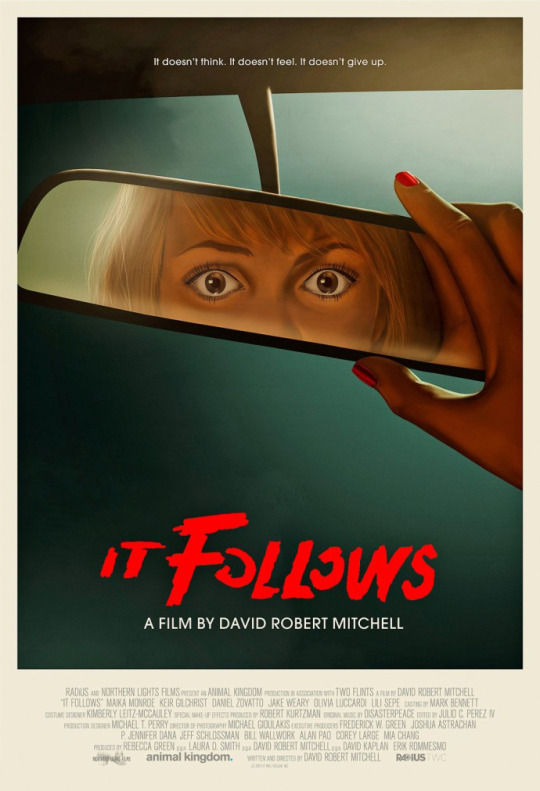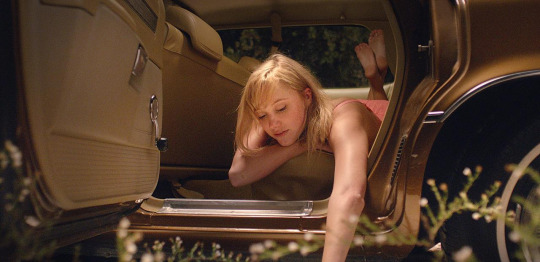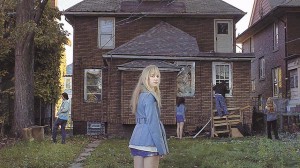Our outgoing Movie Editor Dominic Griffin and Caitlin Goldblatt, the new czar of all things cinema here at Deadshirt, both saw David Robert Mitchell’s It Follows and came to two very different conclusions. In lieu of writing another gushing think piece about it as though it were the first horror movie ever, they decided to have a spoiler-laden discussion about half-assed theme development, the male gaze, and how ambiguity can go too far.
If you have yet to see this film, please rectify that before reading on.
It Follows shows a brief encounter between a young woman, Jay (Maika Monroe), and her lover taking a turn for the worse-than-usual when the latter passes a sexually transmitted poltergeist to the former. The only way to rid oneself of the likelihood of an inevitable, brutal death is to pass the burden to another person via sex. Jay’s friends band around her to help her escape the apparent curse and cope with this major violation of her consent.
C: So, where should we start? Let’s maybe talk about the downsides of the movie first, because that’s a lot more difficult a discussion for me than what’s good about it.
D: For me, the easiest comparison would be The Babadook, in terms of how it uses horror to explore a specific theme, only in The Babadook, the metaphor works really consistently, and here, it just seems like an excuse for a series of scares, but it doesn’t hold together well thematically
C: See, I felt like the film was actually more reminiscent of The Virgin Suicides, and not just because of its 1970s throwbacks and setting in Detroit. It also co-mingled themes addressing the horror of the panoptic suburban mundane and sexuality as a sort of equalizing form of stress and terror. An odd sort of technophobia came across as well. All of this occurs under the umbrella of this dreamy kind of late adolescent viewpoint, which contrasts with an early 2000s Japanese horror aesthetic that isn’t too on the nose. Like, the theft of the future for all of these kids looking into it, which Jay really exemplifies in her post-coital, pre-drugged monologue at the beginning of the film, was actually really scary in a very real way.
D: See, the seeds of technophobia read to me as easy VHS-era nostalgia, but I can see that viewpoint. Visually, it’s engrossing and gorgeous in a really haunted kind of way, but structurally I found it lacking. It felt like two different movies, and something was missing from both.
C: I can see that—I was actually really surprised when they were Home Alone-ing the pool towards the end of the film, but not with any of the omnipresent televisions; it felt like the filmmakers had stepped up to a more concrete theme surrounding technology, and then backed away from it rather than fully realizing it. The framing of the film was extremely impressive. I felt like the cinematography always pointed the viewer to the right place, where the sexually transmitted poltergeist would show up, without necessarily allowing anyone to anticipate the point of entry exactly.
D: I felt the same way about that entire pool setpiece as I did about the third act of Skyfall, which is to say “I see you, but I don’t like this at all.”
C: That’s very true—it was a climax that didn’t feel truly earned, but I suppose the kids were eventually going to have to do something extreme. Also surprising was that I kept expecting Jay to actually accept her fate and try to turn the demon backwards onto all the folks who passed it along so it would eventually be destroyed, but instead she passes it to two people.
D: I found that the monster being so ill-defined was a problem for me. If the youth and sexuality stuff was more well done I wouldn’t have cared, but to lean in so hard in the Elm Street/Wes Craven’s Shocker direction without any real logic bothered the shit out of me. Like, the kid goes from, “We should just bone. That will solve everything!” to “My new plan is very elaborate and based in NOTHING WHATSOEVER!” I was worried for a minute that she was lying about seeing the monster in the pool scene and was trying to get her friends to assist in her suicide.
C: That was what I thought, too! Exactly, like they don’t even know what’s going to kill it, or if they can kill it. That whole situation felt real to me, though, in the sense that everyone was sort of grasping at straws while figuring out how to help Jay emotionally cope with this guy violating her in a severe way. In terms of the film’s commentary on rape culture, it does sort of make sense that she’d try to reach out to her support system to carve out a way to live with it forever.
D: I felt like there was this nebulous, ill-defined nature to the film’s second act. I imagine that haziness is deliberate, but to what end? We never see the aftermath of the monster killing their friend. We never see any parents, really, except when the monster impersonates them. We know Jay passes it to the dude on the boat but we never see it kill him.
C: But we do know that it does kill the boat rando, since the monster reappears. I do think the movie created more problems than it solved by having the monster be identifiable in some way, even to those unable to see it.
D: From the minute they could see it grab that chair on the beach it stopped having the same thematic power, and it just turned into a lackluster thing for me.
C: Well, up until then, I was a little concerned that the “monster” was all in her head as a means of dealing with an actual rape that she was repressing or something, like everyone assumed she was initially doing. That would’ve let me down the same way High Tension did, with its predictable twist that was so likely and misogynistic that it wasn’t even much of a twist.
D: True, but it all feels so muddled around that point. It’s like they want to have it both ways, being a more cerebral rumination on sexuality and isolation as well as a straightforward thriller, and by refusing to choose they do both sides a disservice. I agree that would have been a horrible “twist.”
C: Well, that’s why I think this film deals primarily with teens. That’s such a murky canvas to play out this kind of ambiguity on, but that also becomes lazy at a certain point. I did appreciate that the opening shows what the monster ultimately does to its victims, and I liked that they later showed that it did it by fucking the life out of Greg. Which makes me wonder whether the monster only deals in heteronormative sex.
D: The fact that those two ends were different was strange.
C: Well, I mean, maybe the monster fucked that girl’s brains out before snapping her knees backwards. But it’s definitely a succubus/incubus type of creature; the following things are always nude in some way. Although it’s the opposite of inviting.
D: I didn’t expect them to go see some old sage who read from a dusty tome telling the secret history of IT or whatever, but something about the mythology of it all felt cobbled together. There’s a difference between purposeful ambiguity and lackluster writing, and this film dipped into the latter too many times.
C: See, I really dug that the origin story wasn’t focused on. I feel like that’s an interesting trope in horror films, but I liked that this was all nebulous for these kids. It’s much more realistic that word-of-mouth is how something this scary, something approximating rape in such a real way, would be passed along. The most insidious parts of institutional histories aren’t written down, and that’s why they’re so dangerous.
D: I can’t help but think the filmmaker here had two loose ideas, the image of an unstoppable stalking presence and the STD metaphor, and rather than reconcile the two in any dramatically satisfying way, he stitched it all together with a bit of Rorschach ink blottery so the audience could fill in the blanks for him. I think I just saw the seams on the monster suit and didn’t want to do the work for them. While we’re on the subject of rape…I found it incredibly strange for the sex that sets this all off to be consensual only to have this violation come after.
C: Oh, I found that so perfect. I think it reminded me a lot of when Buffy and Angel first have sex, and then he loses his soul, a metaphor for the danger we face in assuming safety with those to whom we make ourselves vulnerable. I think American audiences need to be doing more of the work—that’s why I liked the framing so much: the film points you there, but doesn’t tell you everything. The best horror and comedy films have this in common, because you’re encouraged to feel so much more than you’re encouraged to merely quote something or screenshot it for Tumblr.
D: I’m all for audience participation and letting them add two and two to get four, but I didn’t feel that here. It felt more disjointed than deliberately open-ended.
C: I think, at worst, that the sex set-up would be a little condescending if it wasn’t so realistic.
D: I am VERY glad you brought up Buffy…because I would have been too nervous to. When Buffy was at its best, they were telling these stories about a young woman’s life and the vampire shit was all just window dressing.
C: Yeah, and I think the horror shit here was actual window dressing in the life of this college girl.
D: The parts I liked the most about It Follows felt like that. The more they focused on the monster, the less I cared. I’m having difficulty articulating the difference, but it just didn’t seem as genuine.
C: The male gaze of the film is so intense, and it’s hard to actually grow into a fully-formed person when all the little boys and men around you are constantly watching you and using you as a figurative and literal vessel. That all felt very real.
D: I agree with that. The omnipresence of dudes and their toxic desires felt honest.
C: I liked the ending for that reason, to be honest, except that she chose Paul/Friend Zone to share her life with. It was so weird that they were both wearing white.
D: That’s what I mean! It felt symbolic, but also thrown together. Like, “IT’S PROVOCATIVE! GETS THE PEOPLE GOING.”
C: The two main dudes in the film were a White Knight and an Elliot Roger type. Like, they had pivotal parts in the plot, but as soon as that brunette Hanson kid stepped on screen, it became essential for him to die as soon as his car ran out of juice. Their characters felt very real, but I was definitely filling in the Reddit-sized holes in their characters’ development.
D: Yeah, and one was Long-Haired And Cool and the other was a less well-dressed Ducky.
C: Exactly. So I get what you mean by the director being a little sloppier than ambiguous. Did you find the constant eBook-reading of The Idiot to be a little dumb for being so esoteric?
D: It was the horror film equivalent of Juno’s hamburger phone.
C: I’m sort of surprised that, for all the vintage home appliances and typewriters in this movie, there wasn’t an actual hamburger phone. Is there anything else in particular you’d like to discuss about the movie?
D: Hmm. I’m trying to think. I was probably not in the best headspace to see it.
C: But your impressions feel very real; maybe you weren’t feeling great, so the entertainment value of the film didn’t make you weigh its shortcomings differently.
D: That’s probably a lot of it…Oh! The score! The score is so legit.
C: OH FUCK YES. The whole Tangerine Dream-meets-the theme from Halloween thing. Sound was used beautifully in this movie, and that’s something I can’t really qualify with a negative. Sound editing is so important, especially in horror, and the music/editing here was perfect. I loved the score, and the moment when the door in that shack blasted open and the little, crawling boy appeared and hissed was perfect.
D: The score is relentless and fucked up and gorgeous and perfect. It really kept me glued even when other elements underwhelmed me.
C: Yeah, what this film lacks in development and tightness, it makes up for in atmosphere.
D: I want to see it again and see if I feel differently.
C: That’s how I felt about Holy Motors when I first saw it, to be honest; I was frustrated with it but something stuck with me and got me to see it again, at which point I realized I dug it a lot. But yeah, I highly recommend seeing it again. I feel like the horror genre is really killing it (HA!) right now with its embrace of non-male, non-final girl, and, hopefully, more non-white and queer protagonists.
It Follows is in select theaters now.





